Overview
- Brief Narrative
- Mixed media drawing created by David Friedmann (from 1960, Friedman) in 1945, depicting a scene in Auschwitz-Birkenau concentration camp, where he was sent in late-August 1944. Artist's caption: "Jewish prisoners on their way to bury a shot down comrade. A smiling and smoking Nazi is watching as two other prisoners are digging a grave. Usually, the prisoners dug their own graves before they were shot. This was an added enjoyment for the Nazis."
David Friedmann was a successful painter and graphic artist who lived in Berlin from 1911-1938. He was renowned for his portraits drawn from life and became a leading press artist of the 1920’s. In 1933, his prewar career abruptly ended with the establishment of the Nazi dictatorship. In December 1938, he escaped to Prague with his wife, Mathilde, and infant daughter, Mirjam Helene. In October 1941, they were deported to the Jewish Ghetto in Łódź, Poland. In late August 1944, the family was separated and sent to Auschwitz death camp, where his wife and child were murdered. He was sent to the subcamp Gleiwitz I, because musicians were sought for a camp orchestra, but Friedmann’s life was saved because of his painting and quick-sketching portrait abilities. The camp was evacuated due to approaching Soviet forces. The inmates were forced on a death march to Blechhammer, where Friedmann was liberated by the Red Army in January 1945. He journeyed to Poland and stayed in Krakow until the war ended in early May 1945. He then returned to Prague and painted the scenes that haunted his memory to show the world and give voice to those who could not be heard. In January 1946, he had his first exhibition of his Holocaust artwork. Friedmann and his second wife, Hildegard, a fellow concentration camp survivor, fled the Stalinist Communists for Israel in 1949. They had a daughter also named Miriam, and the family moved to the United States in 1954. - Artwork Title
- Burying a Shot Comrade
- Series Title
- Because They Were Jews!
- Date
-
depiction:
1944 August-1945 January
creation: 1945
- Geography
-
depiction:
Gleiwitz I (Concentration camp);
Gliwice (Poland)
creation: Prague (Czech Republic)
- Credit Line
- United States Holocaust Memorial Museum Collection, Gift of Hildegard Friedman
- Signature
- front, lower right, painted, brown paint : David Friedmann / 45
- Contributor
-
Artist:
David Friedman
Subject: David Friedman
Subject: Hildegard Friedman
- Biography
-
David Friedmann was born on December 20, 1893, in Mahrisch Ostrau (Ostrava, Czech Republic), part of the Austro-Hungarian Empire. He was the son of Heinrich, a tinsmith, born in 1864 in Kobiernice, and Sophie Rosenblum, born in 1856 in Czaniec. He lived in a modest home with three surviving siblings: Marie, born in 1888, Adolf, born in 1895, and Isidor, born in 1897. In 1911, Friedmann moved to Berlin where he studied etching with Hermann Struck and painting with Lovis Corinth. During World War One, Friedmann served from 1917-1918 in the Austro-Hungarian Army. He was decorated for his work as a combat artist, creating sketches on the frontlines. Following his return to Berlin, Friedmann exhibited at numerous galleries throughout Germany and Czechoslovakia. He achieved acclaim as a painter known for his portraits drawn from life. In 1924, his quick-sketching talent resulted in a secondary career as a freelance press artist for Berlin newspapers and other publications.
When Hitler came to power in Germany in 1933, Friedmann's prewar career ended. As a Jew, he was prohibited from showing his work and had to close his studio. He was able to make a living painting apartments and renovating buildings, which was permitted because of his Czechoslovak citizenship. In 1937, he married Mathilde Fuchs, born October 17, 1901, and they had a daughter, Mirjam Helene, born September 23, 1938. After the Kristallnacht pogrom on November 9-10 1938, Friedmann and his wife, with their infant child, fled from Berlin to Prague. On March 15, 1939, German forces marched into Prague and annexed the region to the Third Reich. Friedmann created portraits of the governing officials and leading members of the Jewish Community of Prague, such as Jakob Edelstein and František Zelenka.
On October 16, 1941, Friedmann and his family were deported on the first transport from Prague to the Łódź Ghetto, renamed Litzmannstadt, in German occupied Poland. The Germans controlled the large Ghetto population with tactics such as the public execution by hanging of 18 Jews who tried to escape, a scene witnessed by Friedmann and his family. All Ghetto residents had to work to receive food rations, but death due to starvation and disease were the norm. Friedmann worked in Metall II designing jewelry, cigarette cases, and badges. He also sketched portraits of the leaders in exchange for provisions; otherwise the family would have perished. He created a series of artworks to document their fate and the infernal life in the Ghetto. He also contributed to the “The Chronicle of the Łódź Ghetto 1941-1944” kept by the Jewish Council.
During the evacuation of the Łódź Ghetto in late August 1944, Friedmann was separated from his family. He was sent, by train on August 29, to Auschwitz-Birkenau concentration camp, where his wife and daughter were murdered. Upon his arrival, on September 2, Friedmann’s arm was tattooed with prisoner No. B-8600. He brought some artwork to show he was an artist, but it had to be discarded upon arrival in Birkenau. Laborers with special skills had a better chance of being sent to labor camps. Artists were not needed, but one day there was a call for musicians. Friedmann passed the audition and was sent to subcamp Gleiwitz I. There he had to compete as a violinist with concert masters, but he wasn't chosen and thus in danger. He painted a mural across the barracks wall that impressed the SS officers and his life was saved. Even though he was forced to create portraits of his persecutors, Friedmann saw his art as a form of resistance that diminished the power of evil and gave him the will to survive. Conditions in the camp were brutal. Meals were a single bowl of watery soup shared by two or three men. Inmates were often beaten, the sick were shipped to Birkenau death camp, and random executions were frequent. On Sundays, inmates had to carry 25 pounds of bricks for three miles. If anyone fell, the guards beat them with their rifles until they got up and finished. These scenes were carved into his memory to tear out at a later time and express in his art. After the Soviets mounted a winter offensive, the camp was evacuated on January 18, 1945. Inmates were forced on a death march to Blechhammer concentration camp. By the end of the march, Friedmann was unable to walk and reached the camp with the aid of the French doctor, Ohrenstein, and two Gruenberger brothers from Slovakia. Friedmann was liberated from Blechhammer by the Soviet Red Army on January 25, 1945.
None of his family survived. His brother, Adolf, who was married to a non-Jew, Kaethe Niesler, died under suspicious circumstances in a Catholic hospital in Berlin on June 29, 1941. His father had died before the war in 1935. His mother died of starvation on December 11, 1941, in the Ostrava Jewish Home for the Aged. Isidor, his wife Sali, and their two children were deported to Theresienstadt, then to Treblinka, and murdered October 10, 1942. Marie and her husband Eisig Feuer were deported to Theresienstadt, then Treblinka and murdered October 7, 1942.
The responsibility of bearing witness weighed heavily on Friedmann's conscience, even before his liberation. Upon returning to Prague, he painted the scenes that haunted his memories to bear witness and give voice to those who could not be heard, creating more than 100 artworks. From January 1946, he had exhibitions featuring his Holocaust themed work in Czechoslovakia, as well as in Palestine. He brought the exhibition to Western Bohemia, where the Germans were still living, and toured through several towns in the former Sudetenland. All German nationals were forced to view his work and pay admission; otherwise they would not receive their ration cards. In 1948, he married Hildegard Taussig, born in Berlin on April 6, 1921, a survivor of several concentration camps. The couple fled to Israel in 1949 because of the Stalinist policies of the Communist government and the increasing anti-Semitism. Friedmann defied an export prohibition and bribed a customs inspector in order to ship his artwork out of the country. In 1954, the couple immigrated to New York with their daughter, also named Miriam. Friedman embarked on a successful career in commercial art with General Outdoor Advertising Company Inc., and settled in St. Louis, Missouri. The family became U.S. citizens and Americanized their surname to one “n”. After retirement in 1962, Friedman returned to his art to show the world the persecution, torment, and agony inflicted by the Nazis. A series of paintings, drawings and etchings entitled, "Because They Were Jews!" became the first art collection to be accepted into the collection of the United States Holocaust Memorial Museum. He never ceased to bear witness about the Holocaust. Friedman died at the age of 86, on February 27, 1980, in St. Louis, Missouri.
Hildegard (Hilde/Hilda) Taussig was born April 6, 1921, in Berlin, Germany. Her father, Karl Taussig, was born in Beroun, Czechoslovakia, September 17, 1888, and her mother, Irma Taussig, née Taussig, was born April 20, 1889 in Prague. The couple married in 1914 and moved to Berlin where Karl worked as a chemical engineer. Hilde had a fraternal twin sister, Ingeborg (Inge), and an older sister, Else, born June 6, 1916. The family moved to Gleiwitz in 1927. Her father continued his career as a chemical engineer. The twins were inseparable and the family enjoyed a comfortable home life.
After Hitler assumed power January 30, 1933, anti-Jewish policies were put in place in Germany. The sisters were subjected to constant humiliations by teachers and students for being Jewish and came home crying daily. Their father finally withdrew the twins from school. Karl was forced to give up his position because he felt threatened at work. On April 4, 1935, the family fled to Prague. It was difficult to make a living there, but Karl found work in a lab. The twins attended trade school to learn Czech, sewing, and cooking, instead of academics. On March 15, 1939, Germany occupied Prague. Else left for Palestine illegally and reached Haifa via the S.S. Sakarya on February 13, 1940. The persecution of Jews intensified. Karl lost his job and gave lessons in German and science. Hilde remarkably found work sewing bathing caps and hats at home, and the family took in a boarder. Karl tried to obtain US visas, but restrictive quotas made this impossible.
On December 11, 1941, the family received the order for transport. Karl notified the authorities that his wife was not well enough to travel because of angina pectoris. He asked if one child could stay to care for her, which the Germans approved. Inge remained behind. On December 14, Hilde and Karl went to the assembly center. The Czechs came out to gloat and jeer as their Jewish neighbors went to their transport. On December 17, they left on Transport N to Ghetto Theresienstadt. Hilde was put in a sick ward. Karl was assigned to Hohenelber Kaserne for those over age fifty. After a week, Hilde was transferred to Podmokly barracks. She worked in the Ordnungsdienst, the order police, and stood all day in freezing weather monitoring activity. She also worked in the laundry and cared for sick and elderly inmates. She rarely saw her father. Hilde was selected for a labor group sent to plant saplings in Krivoklat Forest from April 10-June 6, 1942. Upon returning to Theresienstadt, Hilde found that her belongings had been stolen. Her paternal grandmother, Emma Taussig, had been deported from Prague to Theresienstadt on April 24, 1942, with her daughter, Marie née Polak, who was sent further to Izbica camp and death. Emma became ill due to malnutrition. Hilde cared for Emma until her death of enteritis on June 18.
Transports came in and out of the camp and prisoners lived in terror of being deported east. Hilde became engaged to Josef Loewy. When his mother received the deportation order, he volunteered to join her. Shortly after Josef’s departure September 6, 1943, Hilde became sick with encephalitis. On May 18, 1944, Hilde and her father were shipped on Transport Eb to Auschwitz-Birkenau extermination camp. They were chased out of the cattle cars and met with shouting and random beatings. There was no selection, but Hilde and Karl were separated. Hilde’s left arm was tattooed with number A-4622. She was incarcerated in the "Theresienstadt Family Camp." Hilde searched for her father and when she told another prisoner that Karl was 55, he pointed toward the smokestacks and said that was where her father was. She found Karl, now prisoner A-2377. He told her to save herself and not worry about him, but she resolved to save his life. Hilde helped care for elderly women and survived a brutal beating. The food was horrible and everyone had diarrhea. In early July, the Germans began to liquidate the Family Camp. The women were ordered to undress and march around a table where Mengele and other SS men were seated with their snarling dogs. Hilde alerted her father that she had been selected, took his eyeglasses and advised him to walk straight and tall to appear fit for work. Hilde argued with the room elder to change Karl’s age on his card to 45 years.
Hilde was penned in a holding hut with no standing room in B-Ia women's camp. The guards had promised the return of their shoes, but then threw them into a big pile and laughed as the women fought over them. Hilde got a pair of painfully uncomfortable wooden shoes, many sizes too large. About July 9, Hilde was sent to Christianstadt, a slave labor subcamp of Gross Rosen in Germany. She cleaned for the SS women and the head took a liking to Hilde. This gave her courage to risk asking for the bread crusts from the garbage, which Hilde brought back to her barrack mates. Later, she was assigned to a munitions factory of Dynamit Nobel AG. She sat near a fast moving carousel and filled grenades with hot explosives. Her legs and arms were often burned and she experienced severe nausea from the toxic gas. February 2/3, 1945, the camp was evacuated as the Soviet Red Army approached. The inmates were forced on a death march. Gunshots were continuously heard as soldiers shot those who could not keep up. After four days, Hilde escaped at twilight over the wall of a bridge into icy water. She took along Zdena, a Czech girl who agreed to stay mute. They wandered in the woods before finally finding a house. The woman first told them to go away, then said they could stay one night. The next day, German soldiers came and took them to be questioned. They were asked to prove they were German citizens. Hilde, who had long hair and spoke perfect German, assumed the pseudonym Hilda Lehmann and said they had fled from bombed Sudentengau. A soldier rolled up Hilde’s sleeve to check for a tattoo, but she had sewn the buttons tightly closed and he stopped just before the tattoo became visible. Finally, they were let go and sent to work in a factory. Later, Hilde found work on a farm near Buergel. She was in constant fear of discovery until liberation by American troops in April 1945. Hilde identified herself as a Jew and received a medal for saving Zdena. They were sent to the displaced persons camp at the former Buchenwald concentration camp. Released on June 5, Hilde returned to Prague and reunited with her father. Karl had been sent from Auschwitz to Blechhammer, where he was liberated on January 23, 1945. Hilde and Karl learned that Irma died May 17, 1942, in the Bohnice State Institute in Prague, after a mental breakdown. Inge had been arrested during the wave of reprisals following the assassination of Heydrich, the German Security Chief. Inge was deported June 10, 1942 on Transport AAh to Ujazdow in the Lublin-Chelm area, where she was murdered at the age of 21.
On January 1946, in Cesky Dub, Hilde met David Friedmann, born December 20, 1893, in Mährisch Ostrau (Ostrava, Czech Republic). He was an artist and survivor of the Łódź Ghetto and Auschwitz, Gleiwitz I, and Blechhammmer concentration camps. He sketched the first of many portraits of Hilde and she helped him hang his first postwar exhibition of Holocaust drawings and other works in the Town Hall. In 1947, Karl Taussig married Elisabeth Gluck and they had two daughters. Karl died April 13, 1973, in Israel, at age 85. Hilde and David wed May 27, 1948, in Prague and fled the Stalinist Communists to Israel in 1949. They immigrated to New York in 1954 with their daughter Miriam, and settled in St. Louis, Missouri. The family became U.S. citizens and Americanized their surname to one “n”. Friedman embarked on a successful career in commercial art. After retirement in 1962, Friedman returned to his art to show the world the persecution, torment, and agony inflicted by the Nazis. David died February 27, 1980 at the age of 86, in St. Louis, Missouri. Hilde devoted the remainder of her life promoting his art and speaking about the Holocaust. Hilde died at the age of 67 on January 25, 1989, in New York. She is buried next to her beloved David.
Physical Details
- Classification
-
Art
- Category
-
Drawings
- Object Type
-
Charcoal drawing (lcsh)
- Physical Description
- Framed charcoal and tempera drawing on paper depicting a group of four men: on the left stands a man in a striped jacket and cap, seen in right profile from the waist up, watching two uniformed prisoners with caps hunched over and carrying a bald, barefoot dead man by the shoulders and legs. White painted lines overlay the dark stripes in their brownish uniforms. Just behind the man on the right stands a smiling, dark uniformed, guard with a mustache smoking a cigarette. In the left background, two bent, indistinct figures put a body in a hole in the yard, near the corner of a horizontally lined wooden structure. The light dirt ground behind the figures has a swirl of visible brushstrokes which highlight the muted brown and gray shades of the prisoners. The artist’s signature and date are in the lower right corner. The reverse has two offwhite labels with English text and numbers. The black and gold painted wooden frame has a glass pane.
- Dimensions
- overall: Height: 23.125 inches (58.738 cm) | Width: 29.000 inches (73.66 cm) | Depth: 1.250 inches (3.175 cm)
pictorial area: Height: 16.875 inches (42.863 cm) | Width: 23.000 inches (58.42 cm) - Materials
- overall : paper, charcoal, tempera
Rights & Restrictions
- Conditions on Access
- There are no known restrictions on access to this material.
- Conditions on Use
- Copyright, trademark, and all literary rights are retained by the heir of David Friedman, Miriam Friedman Morris.
- Copyright Holder
- Ms. Miriam F. Morris
Keywords & Subjects
- Topical Term
- Autobiographical memory in art--Pictorial works. Concentration camps--Pictorial works. Concentration camp inmates--Poland--Biography. Holocaust, Jewish (1939-1945), in art. Holocaust, Jewish, (1939-1945)--Poland--Personal narratives. Jewish artists--Czechoslovakia--Biography. Jewish artists--United States--Biography.
- Personal Name
- Friedman, David, 1893-1980.
Administrative Notes
- Legal Status
- Permanent Collection
- Provenance
- The drawing was donated to the United States Holocaust Memorial Museum in 1988 by Hildegard Taussig Friedman, the wife of David Friedman.
- Funding Note
- The cataloging of this artifact has been supported by a grant from the Conference on Jewish Material Claims Against Germany.
- Record last modified:
- 2022-12-14 08:57:01
- This page:
- https://collections.ushmm.org/search/catalog/irn516142
Download & Licensing
In-Person Research
- By Appointment
- Request 21 Days in Advance of Visit
- Plan a Research Visit
- Request to See This Object
Contact Us
Also in David Friedman collection
The collection consists of one etching, eleven drawings and six paintings created by David Friedmann (from 1960, Friedman) after the war based upon his experiences during the Holocaust in the Łódź (Litzmannstadt) Ghetto in Poland from October 1941 - August 1944 and as a prisoner in Auschwitz-Birkenau, Gleiwitz I, and Blechhammer concentration camps from August 1944 until his liberation soon after a death march on January 25, 1945.
Date: 1946-1963
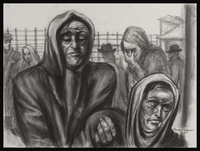
Autobiographical charcoal drawing by David Friedman of a mother helping her sick son in a concentration camp
Object
Charcoal drawing created by David Friedman (before 1960, Friedmann) in 1963, depicting a scene in Auschwitz-Birkenau concentration camp, where he was sent in late-August 1944. It depicts a cloaked woman with a sorrowful face supporting a young man with an emaciated face. Behind them are a woman rubbing her eyes and other figures near a barbed wire fence. Artist's caption: "Mother helping her sick son inside a camp." David Friedmann was a successful painter and graphic artist who lived in Berlin from 1911-1938. He was renowned for his portraits drawn from life and became a leading press artist of the 1920’s. In 1933, his prewar career abruptly ended with the establishment of the Nazi dictatorship. In December 1938, he escaped to Prague with his wife, Mathilde, and infant daughter, Mirjam Helene. In October 1941, they were deported to the Jewish Ghetto in Łódź, Poland. In late August 1944, the family was separated and sent to Auschwitz death camp, where his wife and child were murdered. He was sent to the subcamp Gleiwitz I, because musicians were sought for a camp orchestra, but Friedmann’s life was saved because of his painting and quick-sketching portrait abilities. The camp was evacuated due to approaching Soviet forces. The inmates were forced on a death march to Blechhammer, where Friedmann was liberated by the Red Army in January 1945. He journeyed to Poland and stayed in Krakow until the war ended in early May 1945. He then returned to Prague and painted the scenes that haunted his memory to show the world and give voice to those who could not be heard. In January 1946, he had his first exhibition of his Holocaust artwork. Friedmann and his second wife, Hildegard, a fellow concentration camp survivor, fled the Stalinist Communists for Israel in 1949. They had a daughter also named Miriam, and the family moved to the United States in 1954.
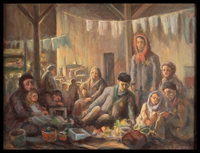
Autobiographical oil painting by David Friedman of a large group of Jews living in an attic in the Łódź Ghetto
Object
Framed oil painting created by David Friedmann (from 1960, Friedman) in 1946, depicting a scene in the Łódź Ghetto, where he was incarcerated from October 1941 until his deportation to Auschwitz-Birkenau concentration camp in late August 1944. It depicts a large group of Jews in their attic living space. David Friedmann was a successful painter and graphic artist who lived in Berlin from 1911-1938. He was renowned for his portraits drawn from life and became a leading press artist of the 1920’s. In 1933, his prewar career abruptly ended with the establishment of the Nazi dictatorship. In December 1938, he escaped to Prague with his wife, Mathilde, and infant daughter, Mirjam Helene. In October 1941, they were deported to the Jewish Ghetto in Łódź, Poland. In late August 1944, the family was separated and sent to Auschwitz death camp, where his wife and child were murdered. He was sent to the subcamp Gleiwitz I, because musicians were sought for a camp orchestra, but Friedmann’s life was saved because of his painting and quick-sketching portrait abilities. The camp was evacuated due to approaching Soviet forces. The inmates were forced on a death march to Blechhammer, where Friedmann was liberated by the Red Army in January 1945. He journeyed to Poland and stayed in Krakow until the war ended in early May 1945. He then returned to Prague and painted the scenes that haunted his memory to show the world and give voice to those who could not be heard. In January 1946, he had his first exhibition of his Holocaust artwork. Friedmann and his second wife, Hildegard, a fellow concentration camp survivor, fled the Stalinist Communists for Israel in 1949. They had a daughter also named Miriam, and the family moved to the United States in 1954.
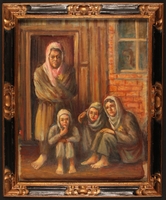
Autobiographical oil painting by David Friedman of a woman and 3 children barefoot and hungry on a Łódź Ghetto street
Object
Framed oil painting created by David Friedmann (from 1960, Friedman) in 1947, depicting a scene in the Łódź Ghetto, where he was incarcerated from October 1941 until his deportation to Auschwitz-Birkenau concentration camp in late August 1944. Artist's caption: "Hungry families on the streets of Łódźer Ghetto were not an unusual, but an every day sight." David Friedmann was a successful painter and graphic artist who lived in Berlin from 1911-1938. He was renowned for his portraits drawn from life and became a leading press artist of the 1920’s. In 1933, his prewar career abruptly ended with the establishment of the Nazi dictatorship. In December 1938, he escaped to Prague with his wife, Mathilde, and infant daughter, Mirjam Helene. In October 1941, they were deported to the Jewish Ghetto in Łódź, Poland. In late August 1944, the family was separated and sent to Auschwitz death camp, where his wife and child were murdered. He was sent to the subcamp Gleiwitz I, because musicians were sought for a camp orchestra, but Friedmann’s life was saved because of his painting and quick-sketching portrait abilities. The camp was evacuated due to approaching Soviet forces. The inmates were forced on a death march to Blechhammer, where Friedmann was liberated by the Red Army in January 1945. He journeyed to Poland and stayed in Krakow until the war ended in early May 1945. He then returned to Prague and painted the scenes that haunted his memory to show the world and give voice to those who could not be heard. In January 1946, he had his first exhibition of his Holocaust artwork. Friedmann and his second wife, Hildegard, a fellow concentration camp survivor, fled the Stalinist Communists for Israel in 1949. They had a daughter also named Miriam, and the family moved to the United States in 1954.
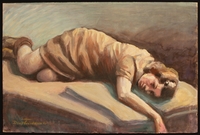
Autobiographical painting by David Friedman of a woman in a brown dress resting on a bed
Object
Oil painting created by David Friedmann (from 1960, Friedman) in 1946 after his return to Prague. It depicts a scene in the Łódź Ghetto, where he was incarcerated from October 1941 until his deportation to Auschwitz-Birkenau concentration camp in late August 1944.. It is a portrait in muted browns of a young woman resting on a bed. The model was Friedmann's second wife, Hildegard Taussig. David Friedmann was a successful painter and graphic artist who lived in Berlin from 1911-1938. He was renowned for his portraits drawn from life and became a leading press artist of the 1920’s. In 1933, his prewar career abruptly ended with the establishment of the Nazi dictatorship. In December 1938, he escaped to Prague with his wife, Mathilde, and infant daughter, Mirjam Helene. In October 1941, they were deported to the Jewish Ghetto in Łódź, Poland. In late August 1944, the family was separated and sent to Auschwitz death camp, where his wife and child were murdered. He was sent to the subcamp Gleiwitz I, because musicians were sought for a camp orchestra, but Friedmann’s life was saved because of his painting and quick-sketching portrait abilities. The camp was evacuated due to approaching Soviet forces. The inmates were forced on a death march to Blechhammer, where Friedmann was liberated by the Red Army in January 1945. He journeyed to Poland and stayed in Krakow until the war ended in early May 1945. He then returned to Prague and painted the scenes that haunted his memory to show the world and give voice to those who could not be heard. In January 1946, he had his first exhibition of his Holocaust artwork. Friedmann and his second wife, Hildegard, a fellow concentration camp survivor, fled the Stalinist Communists for Israel in 1949. They had a daughter also named Miriam, and the family moved to the United States in 1954.
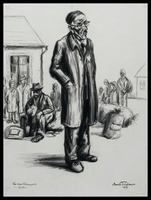
Charcoal drawing by David Friedman of a Jewish man from a suburb of Prague waiting for deportation
Object
Charcoal drawing created by David Friedman (before 1960, Friedmann) in 1963, depicting a scene witnessed prior to his deportation from Prague to the Łódź Ghetto on October 16, 1941. It portrays a Jewish man with eyeglasses, a skullcap, and a Star of David badge on his overcoat. Behind him wait others with packs and bundles. Artist's caption: "A different Jew from a suburb of Prague also is waiting for deportation." David Friedmann was a successful painter and graphic artist who lived in Berlin from 1911-1938. He was renowned for his portraits drawn from life and became a leading press artist of the 1920’s. In 1933, his prewar career abruptly ended with the establishment of the Nazi dictatorship. In December 1938, he escaped to Prague with his wife, Mathilde, and infant daughter, Mirjam Helene. In October 1941, they were deported to the Jewish Ghetto in Łódź, Poland. In late August 1944, the family was separated and sent to Auschwitz death camp, where his wife and child were murdered. He was sent to the subcamp Gleiwitz I, because musicians were sought for a camp orchestra, but Friedmann’s life was saved because of his painting and quick-sketching portrait abilities. The camp was evacuated due to approaching Soviet forces. The inmates were forced on a death march to Blechhammer, where Friedmann was liberated by the Red Army in January 1945. He journeyed to Poland and stayed in Krakow until the war ended in early May 1945. He then returned to Prague and painted the scenes that haunted his memory to show the world and give voice to those who could not be heard. In January 1946, he had his first exhibition of his Holocaust artwork. Friedmann and his second wife, Hildegard, a fellow concentration camp survivor, fled the Stalinist Communists for Israel in 1949. They had a daughter also named Miriam, and the family moved to the United States in 1954.
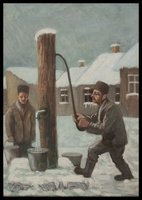
Autobiographical tempera painting by David Friedmann of two men pumping water in the Łódź Ghetto
Object
Tempera painting, mat, and frame created by David Friedmann (from 1960, Friedman) in 1946 of the water pump in the Łódź Ghetto where he did the family's washing in summer and winter. Friedmann was incarcerated in the Ghetto from October 1941 until his deportation to Auschwitz-Birkenau concentration camp in late August 1944. It depicts two men in heavy clothing with Stars of David pumping water in a snow covered yard. David Friedmann was a successful painter and graphic artist who lived in Berlin from 1911-1938. He was renowned for his portraits drawn from life and became a leading press artist of the 1920’s. In 1933, his prewar career abruptly ended with the establishment of the Nazi dictatorship. In December 1938, he escaped to Prague with his wife, Mathilde, and infant daughter, Mirjam Helene. In October 1941, they were deported to the Jewish Ghetto in Łódź, Poland. In late August 1944, the family was separated and sent to Auschwitz death camp, where his wife and child were murdered. He was sent to the subcamp Gleiwitz I, because musicians were sought for a camp orchestra, but Friedmann’s life was saved because of his painting and quick-sketching portrait abilities. The camp was evacuated due to approaching Soviet forces. The inmates were forced on a death march to Blechhammer, where Friedmann was liberated by the Red Army in January 1945. He journeyed to Poland and stayed in Krakow until the war ended in early May 1945. He then returned to Prague and painted the scenes that haunted his memory to show the world and give voice to those who could not be heard. In January 1946, he had his first exhibition of his Holocaust artwork. Friedmann and his second wife, Hildegard, a fellow concentration camp survivor, fled the Stalinist Communists for Israel in 1949. They had a daughter also named Miriam, and the family moved to the United States in 1954.
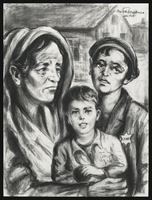
Autobiographical charcoal drawing by David Friedman of a mother with two children in Lodzer Ghetto
Object
Charcoal drawing created by David Friedman (before 1960, Friedmann) in 1964, depicting a scene in the Łódź Ghetto, where he was incarcerated from October 1941 until his deportation to Auschwitz-Birkenau concentration camp in late August 1944. It depicts a worn and exhausted woman with two children; all wearing Judenstern. Artist's caption: "Mother with two children in Łódźer Ghetto (Litzmannstadt). Her husband was working in a German factory." David Friedmann was a successful painter and graphic artist who lived in Berlin from 1911-1938. He was renowned for his portraits drawn from life and became a leading press artist of the 1920’s. In 1933, his prewar career abruptly ended with the establishment of the Nazi dictatorship. In December 1938, he escaped to Prague with his wife, Mathilde, and infant daughter, Mirjam Helene. In October 1941, they were deported to the Jewish Ghetto in Łódź, Poland. In late August 1944, the family was separated and sent to Auschwitz death camp, where his wife and child were murdered. He was sent to the subcamp Gleiwitz I, because musicians were sought for a camp orchestra, but Friedmann’s life was saved because of his painting and quick-sketching portrait abilities. The camp was evacuated due to approaching Soviet forces. The inmates were forced on a death march to Blechhammer, where Friedmann was liberated by the Red Army in January 1945. He journeyed to Poland and stayed in Krakow until the war ended in early May 1945.He then returned to Prague and painted the scenes that haunted his memory to show the world and give voice to those who could not be heard. In January 1946, he had his first exhibition of his Holocaust artwork. Friedmann and his second wife, Hildegard, a fellow concentration camp survivor, fled the Stalinist Communists for Israel in 1949. They had a daughter also named Miriam, and the family moved to the United States in 1954.
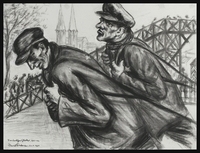
Autobiographical charcoal drawing by David Friedman of newcomers to the Łódź Ghetto pulling a carriage
Object
Charcoal drawing created by David Friedman (before 1960, Friedmann) in 1964, depicting a scene in the Łódź Ghetto, where he was incarcerated from October 1941 until his deportation to Auschwitz-Birkenau concentration camp in late August 1944. Artist's caption: "Newcomers in the Łódźer Ghetto pulling a carriage. In the background there is a Catholic church. At the time it was used for storage of bedfeathers taken by force from the Jews by the Nazis in that region. The wood bridge went to another part of the ghetto, and the street under the bridge was only for Germans. Watching soldiers were at every hundred feet." David Friedmann was a successful painter and graphic artist who lived in Berlin from 1911-1938. He was renowned for his portraits drawn from life and became a leading press artist of the 1920’s. In 1933, his prewar career abruptly ended with the establishment of the Nazi dictatorship. In December 1938, he escaped to Prague with his wife, Mathilde, and infant daughter, Mirjam Helene. In October 1941, they were deported to the Jewish Ghetto in Łódź, Poland. In August 1944, the family was separated and sent to Auschwitz death camp, where his wife and child were murdered. He was sent to the subcamp Gleiwitz I, because musicians were sought for a camp orchestra, but Friedmann’s life was saved because of his painting and quick-sketching portrait abilities. The camp was evacuated due to approaching Soviet forces. The inmates were forced on a death march to Blechhammer, where Friedmann was liberated by the Red Army in January 1945. He journeyed to Poland and stayed in Krakow until the war ended in early May 1945. He then returned to Prague and painted the scenes that haunted his memory to show the world and give voice to those who could not be heard. In January 1946, he had his first exhibition of his Holocaust artwork. Friedmann and his second wife, Hildegard, a fellow concentration camp survivor, fled the Stalinist Communists for Israel in 1949. They had a daughter also named Miriam, and the family moved to the United States in 1954.
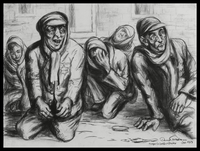
Autobiographical charcoal drawing by David Friedman of despairing and hungry Jews in the Łódź Ghetto
Object
Charcoal drawing created by David Friedman (before 1960, Friedmann) in 1963, depicting a scene in the Łódź Ghetto, where he was incarcerated from October 1941 until his deportation to Auschwitz-Birkenau concentration camp in late August 1944. It depicts people with Star of David badges begging on the street. Artist's caption: "Despairing and hungry people on streets in Łódźer Ghetto was one of the frequent sights to be seen. Official statistics: From 110,798 inmates between 1940-1944, 43, 441 perished. In May 1941, 20,000 Jews were officially registered for TB. But there were many other diseases too." David Friedmann was a successful painter and graphic artist who lived in Berlin from 1911-1938. He was renowned for his portraits drawn from life and became a leading press artist of the 1920’s. In 1933, his prewar career abruptly ended with the establishment of the Nazi dictatorship. In December 1938, he escaped to Prague with his wife, Mathilde, and infant daughter, Mirjam Helene. In October 1941, they were deported to the Jewish Ghetto in Łódź, Poland. In late August 1944, the family was separated and sent to Auschwitz death camp, where his wife and child were murdered. He was sent to the subcamp Gleiwitz I, because musicians were sought for a camp orchestra, but Friedmann’s life was saved because of his painting and quick-sketching portrait abilities. The camp was evacuated due to approaching Soviet forces. The inmates were forced on a death march to Blechhammer, where Friedmann was liberated by the Red Army in January 1945. He journeyed to Poland and stayed in Krakow until the war ended in early May 1945. He then returned to Prague and painted the scenes that haunted his memory to show the world and give voice to those who could not be heard. In January 1946, he had his first exhibition of his Holocaust artwork. Friedmann and his second wife, Hildegard, a fellow concentration camp survivor, fled the Stalinist Communists for Israel in 1949. They had a daughter also named Miriam, and the family moved to the United States in 1954.
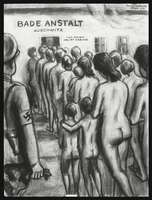
Autobiographical charcoal drawing by David Friedman of naked women and children entering the showers at Auschwitz
Object
Charcoal drawing created by David Friedman (before 1960, Friedmann) in 1964, depicting a scene in Auschwitz-Birkenau concentration camp, where he was sent in late-August 1944. It depicts two long lines of naked women and children entering a doorway marked Bade Anstalt (Bathing Establishment.) Artist's caption: "This is Auschwitz-Birkenau! This camp, like Maidanek, Treblinka, and many others, was destined to destroy Jewish people. Bathing Establishment was posted outside, but it was also used as a gas-chamber. The Nazis enjoyed to fool us. The camp was full of smoke and a horrible odor, but at that time, we had no knowledge, and would never have believed that the smell came from burned human bodies." David Friedmann was a successful painter and graphic artist who lived in Berlin from 1911-1938. He was renowned for his portraits drawn from life and became a leading press artist of the 1920’s. In 1933, his prewar career abruptly ended with the establishment of the Nazi dictatorship. In December 1938, he escaped to Prague with his wife, Mathilde, and infant daughter, Mirjam Helene. In October 1941, they were deported to the Jewish Ghetto in Łódź, Poland. In August 1944, the family was separated and sent to Auschwitz death camp, where his wife and child were murdered. He was sent to the subcamp Gleiwitz I, because musicians were sought for a camp orchestra, but Friedmann’s life was saved because of his painting and quick-sketching portrait abilities. The camp was evacuated due to approaching Soviet forces. The inmates were forced on a death march to Blechhammer, where Friedmann was liberated by the Red Army in January 1945. He journeyed to Poland and stayed in Krakow until the war ended in early May 1945. He then returned to Prague and painted the scenes that haunted his memory to show the world and give voice to those who could not be heard. In January 1946, he had his first exhibition of his Holocaust artwork. Friedmann and his second wife, Hildegard, a fellow concentration camp survivor, fled the Stalinist Communists for Israel in 1949. They had a daughter named Miriam, and the family moved to the United States in 1954.
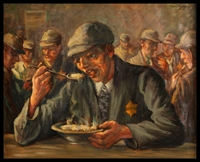
Autobiographical oil painting by David Friedman of a man with a Star of David badge eating in a Łódź Ghetto food hall
Object
Framed oil painting created by David Friedmann (from 1960, Friedman) in 1947, depicting a scene in the Łódź Ghetto, where he was incarcerated from October 1941 until his deportation to Auschwitz-Birkenau concentration camp in late August 1944. It depicts a seated man with a Star of David badge eating at a table. Artists's caption: "Eating in a public kitchen or eating at home, the consequences were the same. Many Jews died every day from hunger and disease. For example, in four days between Feb. 22-26, 307 persons died: 74 persons died from TB. 105 persons died from weakness of the heart. 128 persons died from hunger." David Friedmann was a successful painter and graphic artist who lived in Berlin from 1911-1938. He was renowned for his portraits drawn from life and became a leading press artist of the 1920’s. In 1933, his prewar career abruptly ended with the establishment of the Nazi dictatorship. In December 1938, he escaped to Prague with his wife, Mathilde, and infant daughter, Mirjam Helene. In October 1941, they were deported to the Jewish Ghetto in Łódź, Poland. In late August 1944, the family was separated and sent to Auschwitz death camp, where his wife and child were murdered. He was sent to the subcamp Gleiwitz I, because musicians were sought for a camp orchestra, but Friedmann’s life was saved because of his painting and quick-sketching portrait abilities. The camp was evacuated due to approaching Soviet forces. The inmates were forced on a death march to Blechhammer, where Friedmann was liberated by the Red Army in January 1945. He journeyed to Poland and stayed in Krakow until the war ended in early May 1945. He then returned to Prague and painted the scenes that haunted his memory to show the world and give voice to those who could not be heard. In January 1946, he had his first exhibition of his Holocaust artwork. Friedmann and his second wife, Hildegard, a fellow concentration camp survivor, fled the Stalinist Communists for Israel in 1949. They had a daughter also named Miriam, and the family moved to the United States in 1954.
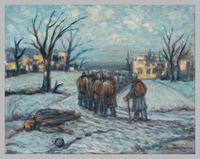
Autobiographical oil painting by David Friedman of freed prisoners homeward bound
Object
Framed oil painting created by David Friedmann (from 1960, Friedman) in 1946, based upon scenes he witnessed after his liberation on January 25, 1945, following a death march to Blechhammer slave labor camp. The painting depicts a long line of men in prison garb walking in the snow; a dead body on the roadside. Artist's caption: "It was a long way home and it wasn't unusual to see comrades as well as German soldiers dead on the road." David Friedmann was a successful painter and graphic artist who lived in Berlin from 1911-1938. He was renowned for his portraits drawn from life and became a leading press artist of the 1920’s. In 1933, his prewar career abruptly ended with the establishment of the Nazi dictatorship. In December 1938, he escaped to Prague with his wife, Mathilde, and infant daughter, Mirjam Helene. In October 1941, they were deported to the Jewish Ghetto in Łódź, Poland. In late August 1944, the family was separated and sent to Auschwitz death camp, where his wife and child were murdered. He was sent to the subcamp Gleiwitz I, because musicians were sought for a camp orchestra, but Friedmann’s life was saved because of his painting and quick-sketching portrait abilities. The camp was evacuated due to approaching Soviet forces. The inmates were forced on a death march to Blechhammer, where Friedmann was liberated by the Red Army in January 1945. He journeyed to Poland and stayed in Krakow until the war ended in early May 1945. He then returned to Prague and painted the scenes that haunted his memory to show the world and give voice to those who could not be heard. In January 1946, he had his first exhibition of his Holocaust artwork. Friedmann and his second wife, Hildegard, a fellow concentration camp survivor, fled the Stalinist Communists for Israel in 1949. They had a daughter also named Miriam, and the family moved to the United States in 1954.
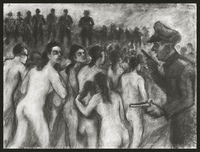
Autobiographical charcoal drawing by David Friedman of mothers, ordered to undress, who stare at their executioners as they march with their children into a mass grave
Object
Charcoal drawing created by David Friedmann (from 1960, Friedman) circa 1945-48, depicting a scene in Auschwitz-Birkenau concentration camp, where he was sent in late-August 1944. It depicts a large crowd of naked women and children being herded by shadowy armed soldiers into a big pit to be shot. David Friedmann was a successful painter and graphic artist who lived in Berlin from 1911-1938. He was renowned for his portraits drawn from life and became a leading press artist of the 1920’s. In 1933, his prewar career abruptly ended with the establishment of the Nazi dictatorship. In December 1938, he escaped to Prague with his wife, Mathilde, and infant daughter, Mirjam Helene. In October 1941, they were deported to the Jewish Ghetto in Łódź, Poland. In late August 1944, the family was separated and sent to Auschwitz death camp, where his wife and child were murdered. He was sent to the subcamp Gleiwitz I, because musicians were sought for a camp orchestra, but Friedmann’s life was saved because of his painting and quick-sketching portrait abilities. The camp was evacuated due to approaching Soviet forces. The inmates were forced on a death march to Blechhammer, where Friedmann was liberated by the Red Army in January 1945. He journeyed to Poland and stayed in Krakow until the war ended in early May 1945.He then returned to Prague and painted the scenes that haunted his memory to show the world and give voice to those who could not be heard. In January 1946, he had his first exhibition of his Holocaust artwork. Friedmann and his second wife, Hildegard, a fellow concentration camp survivor, fled the Stalinist Communists for Israel in 1949. They had a daughter also named Miriam, and the family moved to the United States in 1954.
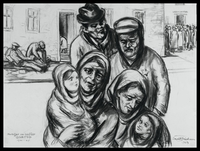
Autobiographical charcoal drawing by David Friedman of two Jewish couples and their children huddled on a Ghetto street
Object
Charcoal drawing created by David Friedman (before 1960, Friedmann) in 1963, depicting a scene in the Łódź Ghetto, where he was incarcerated from October 1941 until his deportation to Auschwitz-Birkenau concentration camp in late August 1944. It depicts two anguished couples with two children, standing close together in the foreground. Behind them, a crowd of people stand in line near a building. Artist's caption: "Despairing and hungry people on the streets of Łódź Ghetto was one of the frequent sights to be seen. In the background, people are standing in front of a food distribution center. Some are turned away because supplies ran out. People are starving, which was what Hitler wanted." David Friedmann was a successful painter and graphic artist who lived in Berlin from 1911-1938. He was renowned for his portraits drawn from life and became a leading press artist of the 1920’s. In 1933, his prewar career abruptly ended with the establishment of the Nazi dictatorship. In December 1938, he escaped to Prague with his wife, Mathilde, and infant daughter, Mirjam Helene. In October 1941, they were deported to the Jewish Ghetto in Łódź, Poland. In August late 1944, the family was separated and sent to Auschwitz death camp, where his wife and child were murdered. He was sent to the subcamp Gleiwitz I, because musicians were sought for a camp orchestra, but Friedmann’s life was saved because of his painting and quick-sketching portrait abilities. The camp was evacuated due to approaching Soviet forces. The inmates were forced on a death march to Blechhammer, where Friedmann was liberated by the Red Army in January 1945. He journeyed to Poland and stayed in Krakow until the war ended in early May 1945. He then returned to Prague and painted the scenes that haunted his memory to show the world and give voice to those who could not be heard. In January 1946, he had his first exhibition of his Holocaust artwork. Friedmann and his second wife, Hildegard, a fellow concentration camp survivor, fled the Stalinist Communists for Israel in 1949. They had a daughter also named Miriam, and the family moved to the United States in 1954.
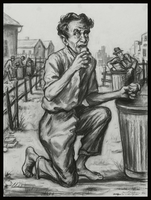
Autobiographical charcoal drawing by David Friedman of a starving man eating from a ghetto garbage can
Object
Charcoal drawing created by David Friedman (before 1960, Friedmann) in 1964, depicting a scene in the Łódź Ghetto, where he was incarcerated from October 1941 until his deportation to Auschwitz-Birkenau concentration camp in late August 1944. It depicts a man kneeling in front of a garbage can and eating. The artist's caption: "People are looking for some food in backyards, but if you were caught from German detectives, you were shot pitilessly. With my binocular from Prague, I saw more than others. For a 1/2 lb potato peelings I had to pay $1.00 in fresh condition." David Friedmann was a successful painter and graphic artist who lived in Berlin from 1911-1938. He was renowned for his portraits drawn from life and became a leading press artist of the 1920’s. In 1933, his prewar career abruptly ended with the establishment of the Nazi dictatorship. In December 1938, he escaped to Prague with his wife, Mathilde, and infant daughter, Mirjam Helene. In October 1941, they were deported to the Jewish Ghetto in Łódź, Poland. In August 1944, the family was separated and sent to Auschwitz death camp, where his wife and child were murdered. He was sent to the subcamp Gleiwitz I, because musicians were sought for a camp orchestra, but Friedmann’s life was saved because of his painting and quick-sketching portrait abilities. The camp was evacuated due to approaching Soviet forces. The inmates were forced on a death march to Blechhammer, where Friedmann was liberated by the Red Army in January 1945. He journeyed to Poland and stayed in Krakow until the war ended in early May 1945.He then returned to Prague and painted the scenes that haunted his memory to show the world and give voice to those who could not be heard. In January 1946, he had his first exhibition of his Holocaust artwork. Friedmann and his second wife, Hildegard, a fellow concentration camp survivor, fled the Stalinist Communists for Israel in 1949. They had a daughter also named Miriam, and the family moved to the United States in 1954.
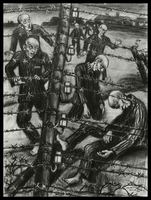
Autobiographical charcoal drawing by David Friedman of concentration camp inmates who preferred the electric wire rather than more tortures
Object
Charcoal drawing created by David Friedman (before 1960, Friedmann) in 1964, depicting a scene in Auschwitz-Birkenau concentration camp, where he was sent in late-August 1944. It depicts prisoners throwing themselves against barbed wire electric fences. Artists's caption: " Some prisoners preferred the electric wire rather than more tortures. They work hard for little food, lost the ability to think and lost also their nerves. Food was even not good enough for pigs." David Friedmann was a successful painter and graphic artist who lived in Berlin from 1911-1938. He was renowned for his portraits drawn from life and became a leading press artist of the 1920’s. In 1933, his prewar career abruptly ended with the establishment of the Nazi dictatorship. In December 1938, he escaped to Prague with his wife, Mathilde, and infant daughter, Mirjam Helene. In October 1941, they were deported to the Jewish Ghetto in Łódź, Poland. In late August 1944, the family was separated and sent to Auschwitz death camp, where his wife and child were murdered. He was sent to the subcamp Gleiwitz I, because musicians were sought for a camp orchestra, but Friedmann’s life was saved because of his painting and quick-sketching portrait abilities. The camp was evacuated due to approaching Soviet forces. The inmates were forced on a death march to Blechhammer, where Friedmann was liberated by the Red Army in January 1945. He journeyed to Poland and stayed in Krakow until the war ended in early May 1945. He then returned to Prague and painted the scenes that haunted his memory to show the world and give voice to those who could not be heard. In January 1946, he had his first exhibition of his Holocaust artwork. Friedmann and his second wife, Hildegard, a fellow concentration camp survivor, fled the Stalinist Communists for Israel in 1949. They had a daughter also named Miriam, and the family moved to the United States in 1954.
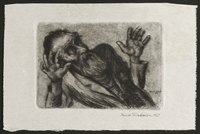
Etched print created by David Friedman of a man kneeling in despair a few seconds before execution
Object
Drypoint etching printed by David Friedman (before 1960, Friedmann) in 1967, depicting a scene in Auschwitz-Birkenau concentration camp, where he was sent in late-August 1944. It depicts a bearded man with a Star of David badge, reeling backward, hands raised in terror. Artist's caption: "This man is kneeling in despair a few seconds before execution." David Friedmann was a successful painter and graphic artist who lived in Berlin from 1911-1938. He was renowned for his portraits drawn from life and became a leading press artist of the 1920’s. In 1933, his prewar career abruptly ended with the establishment of the Nazi dictatorship. In December 1938, he escaped to Prague with his wife, Mathilde, and infant daughter, Mirjam Helene. In October 1941, they were deported to the Jewish Ghetto in Łódź, Poland. In late August 1944, the family was separated and sent to Auschwitz death camp, where his wife and child were murdered. He was sent to the subcamp Gleiwitz I, because musicians were sought for a camp orchestra, but Friedmann’s life was saved because of his painting and quick-sketching portrait abilities. The camp was evacuated due to approaching Soviet forces. The inmates were forced on a death march to Blechhammer, where Friedmann was liberated by the Red Army in January 1945. He journeyed to Poland and stayed in Krakow until the war ended in early May 1945. He then returned to Prague and painted the scenes that haunted his memory to show the world and give voice to those who could not be heard. In January 1946, he had his first exhibition of his Holocaust artwork. Friedmann and his second wife, Hildegard, a fellow concentration camp survivor, fled the Stalinist Communists for Israel in 1949. They had a daughter also named Miriam, and the family moved to the United States in 1954.



